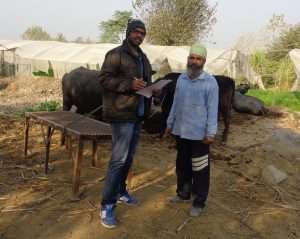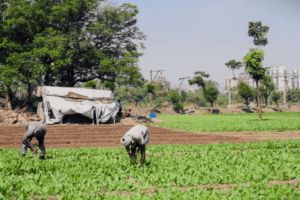Milk is an important component of the human diet and simultaneously a source of antimicrobial resistance and residues. The One-Health approach has largely focussed on milk health and nutrition but there are other issues requiring consideration. In this risk communication blog, Neela Madhav Patnaik, Jancy Gupta, and Maria Correa discuss the various facets of antimicrobial resistance and residues in milk, and the possible effects on human health.
CONTEXT
Milk is a wholesome product, produced in an environment controlled by human actions, including the use of antimicrobials. Antimicrobial residues could enter the human food chain and have toxicological effects on humans (Khaniki 2007). Infants and growing children are more susceptible than other age groups to residues given their higher consumption of milk and milk products. Antimicrobial resistance (AMR) is also a human health concern (Scoppetta et al. 2016) because humans will slowly develop resistance to antibiotics that could be needed to treat human ailments (Katakweba et al. 2012). Thus, ensuring that milk and milk products are safe from antimicrobial residues is critically important.
How do we decrease AMR and residues in milk and milk products? The answer to this question is not an easy one. The challenge involves small and big stakeholders, dairy cooperatives, milk processing and marketing groups, veterinarians and para-veterinary personnel, researchers, and public policy makers.
ANTIMICROBIAL RESIDUES IN MILK AND MILK PRODUCTS
Antimicrobial drugs are important for treating human infections and in animal health, therefore AMR and residues could be present in milk and milk products. The presence of antimicrobial residues in milk is well-known (Cepurnieks et al. 2015; Kabera et al. 2018; Baynes et al. 2016; Moudgil et al. 2019). Antimicrobial residues in milk affect milk quality and inhibit the starter cultures for milk products (Addo et al. 2011). Pasteurization and other heat treatment methods are effective in eliminating pathogenic microbes but their effect on drug residues is limited (Kang et al. 2005). Mastitis treatments with antimicrobials or bacteria-contaminated milk show wide-spectrum resistance to a variety of antibiotics (Aires-de-Sousa 2017; Kumar et al. 2010). Common causes of residues in milk can be attributed to extra-label drugs, over the counter antibiotics sale, poor farm records, non-compliance with the withdrawal period, among others. Residues in milk are a public health concern and policy makers’ involvement is necessary to increase detection, quantification, and control. Two important associated concepts are the maximum residue limit and withdrawal periods.
Maximum Residue Limit
Maximum Residue Limit (MRL) can be defined as the acceptable or permitted maximum concentration of residue in milk. MRL is based on toxicological data and includes absorption, distribution, metabolism, and excretion (Bedi et al. 2015). Milk and milk products containing residues above the recommended MRL are detrimental to consumers’ health and are related to a number of human health issues (Wang et al. 2017). AMR can be life threatening when a person is resistant to an antibiotic needed for a particular ailment (Aalipour et al. 2015). The Food Safety and Standards Authority of India (FSSAI) regulates the food MRLs of 103 antibiotics and other veterinary drugs in milk, fish, poultry, meat and meat products and is in sync with the Codex Alimentarius.
Withdrawal Period
Withdrawal period refers to the time required for the residues of concerned antimicrobials to reach safe concentration levels. Withdrawal time varies considerably depending on the chemical and physical properties of the antimicrobial, the administration route, and the recommended dosage level if antibiotics contribute to the problem with milk residues (Laxminarayan et al. 2015). In Punjab, a survey on antimicrobial use indicated that none of the sampled farmers interviewed discarded the milk of treated animals (Patnaik et al. 2019a). The reason for this practice was mainly monetary loss. Farmers lacked knowledge of the withdrawal period. Furthermore, they indicated there were no incentives for residue-free production. The need for extension interventions and actions plans is obvious.
 Interaction with Punjab livestock farmer on management of post-antimicrobial treated animals
Interaction with Punjab livestock farmer on management of post-antimicrobial treated animals
ANTIMICROBIAL USE IN THE DAIRY SECTOR AND ITS EFFECT ON HUMAN HEALTH
The different types of antimicrobials include antibiotics, antiprotozoal, and antifungals products. Dairy antimicrobial therapeutical treatments are for clinical diseases, in prophylactic use it is for disease prevention and control, and in the case of sub-therapeutical use it is for growth promotion (Patnaik et al. 2019b). The most prescribed drugs for dairy include tetracyclines, quinolones, aminoglycosides, beta-lactams, sulphonamides, and macrolides (Huber et al. 2010). The drugs may be prescribed singly or in combination for treating ailments in dairy animals and can be administered through different methods (e.g., oral, intra-uterine, intra-mammary and tropical). Oxytetracycline, chloramphenicol and streptomycin are the drugs excreted through milk due to their pharmacokinetics (Zahid et al. 2010). WHO (2007) listed critically important antimicrobials for human health that need to be restricted in the dairy sector, for example, Gentamycin, Erythromycin, Ampicillin, Cefadroxil, Amoxycillin, Chlortetracycline, Sulfadiazine, Doxycycline, Flumequine, Veneomycin, Spiramycin, and Sulfadimethoxine.
Though antimicrobials have improved animal health and milk production, antimicrobial resistance is a huge concern in the dairy industry. Indiscriminate use of antimicrobials increases the possibility of resistant bacteria and transmission from animals to humans. Given the importance of veterinarians in different field situations and as a vehicle of information for farmers (Patnaik et al. 2019c), in-service training programs for livestock department personnel should include emerging trends in AMR policies and control measures (Ramesh et al. 2018). The acute and chronic adverse effects in humans are summarised as nephropathy, mutagenicity (Gentamicin); reproductive disorders, bone marrow toxicity, hepatotoxicity (Chloramphenicol); allergy (Penicillin) and carcinogenicity (Oxytetracycline, Sulphamethazine). Chronic exposure to oxytetracycline results in changes in blood such as atypical lymphocytes and leucocytosis, lung congestion, thrombocytopenia purpura and toxic granulation of granulocytes, and brown discolouration of the teeth (Navratilova et al. 2009).
| BOX-1 GLOBAL AMR CONTROL INITIATIVES As a global threat, AMR if unchecked by 2050 is predicted to be associated with an estimated loss of 10 million lives, and yearly global GDP loss of 1.1 – 3.8%. A multifaceted strategy has been developed by WHO (2015) with five objectives including a reduction of the incidence of infection; promotion of judicial use of antimicrobials; perception improvement and understanding of AMR; knowledge strengthening through research and surveillance; and the investigation of sustainable development for new medicines, vaccines, and diagnostic tools. In 2011, the European Union (EU) developed an action-plan framework advocating the control, emergence, and spread of AMR. The United States of America, the United Kingdom, Canada, and the EU, have well-coordinated AMR strategic action plans (Kasimanickam et al. 2021). Some of the developing countries seem to lack AMR national action plans, infrastructure, and have a poor understanding of antimicrobial use, improper regulation and compliance (Pokharel et al. 2019). In 2017, in India, the National Action Plan for AMR was conceived with a focus on surveillance, awareness increase, prevention and infection control, research, antimicrobial use, investing in collaborative work across health care and livestock sectors. |
EXTENSION INVOLVEMENT ON AMR ISSUES IN THE DAIRY SECTOR
Antimicrobial use in the dairy sector and herd-health management involves mainly stakeholders and veterinarians. AMR control has gained momentum in India and it is an emerging field. This opens exciting opportunities for extension personnel and researchers to make significant contributions towards AMR containment at the national level.
Dairy farmers’ attitude, knowledge level, risk perception, and expectations from antimicrobial use, are important issues to consider in extension research. Devising AMR stewardship programs and action plans ought to actively involve primary stakeholders, effective communication, and information exchange. Many external variables associated with farming (e.g., housing conditions, animal sanitation) and personal variables (e.g., farmers’ age, education) are involved in antimicrobial use decisions (Willock et al. 1999). Additionally, antimicrobial price, withdrawal period, antimicrobial education level, and farmers’ socio-economic status, are other factors highlighted by Gibbons et al. (2012) and Patnaik et al. (2020). Antimicrobial use practices in both humans and livestock sector have shifted the attention to reducing and optimizing antimicrobial use in dairy farms (EFSA and ECDC 2013). Developing interventions for the judicial use of antimicrobials require surveying the internal and antecedent variables and considering farmers’ and veterinarians’ perspectives on antimicrobial use and prescription practices.
THE WAY FORWARD
Based on our experience, we recommend the following herd-health practices (non-exhaustive list):
- Recording dairy antimicrobial use and residues present in milk through a monitoring and surveillance system;
- Structured campaign and awareness drives on AMR issues for farmers, veterinarians, and the general public;
- Development of dairy regulations and enforced capabilities for antimicrobial use;
- Focused research on alternative treatments;
- Sensitivity-testing centers at the village level to facilitate appropriate antimicrobial prescriptions by veterinarians;
- Bio-security measures to be followed at dairies to prevent infection spread;
- An identification system for antimicrobial-treated animals that complies with the withdrawal period; and
- Additional incentives given to farmers with residue-free milk.
CONCLUSIONS
Producing good quality milk without antimicrobial residues should be a priority for the dairy sector. The high incidence of antimicrobials in milk and ever-increasing reports on MRLs above recommended levels, points towards widespread use and misuse of antimicrobials in dairy animals. Inflating the problem is the lack of a consistent regulatory framework for antimicrobial use. Although many organizations and researchers advocate the ban of antimicrobials in livestock, this proposition is unlikely to succeed given the economic factors needed to maintain a large livestock population in India, and the heavy dependence of rural owners on livestock for their livelihood. Instead, farmers ought to be informed on proper antimicrobial handling and on the importance of the withdrawal period. Along with good communication, monitoring and surveillance of veterinary drug use, increased understanding of antimicrobial resistance, and intra- and inter-agency collaboration, will facilitate appropriate planning, program development, and policy making.
REFERENCES
Aalipour F, Mirlohi M, Jalali M and Azadbakht L. 2015. Dietary exposure to tetracycline residues through milk consumption in Iran. Journal of Environmental Health Science and Engineering 13(1):80.
Addo KK, Mensah GI, Aning KG, Nartey N, Nipah GK, Bonsu C, Akyeh ML and Smits HL. 2011. Microbiological quality and antibiotic residues in informally marketed raw cow milk within the coastal savannah zone of Ghana. Tropical Medicine and International Health 16(2):227-232.
Aires-de-Sousa M. 2017. Methicillin-resistant Staphylococcus aureus among animals: Current overview. Clinical Microbiology and Infection 23(6):373-380.
Baynes RE, Dedonder K, Kissell L, Mzyk D, Marmulak T, Smith G, Tell L, Gehring R, Davis J and Riviere JE. 2016. Health concerns and management of select veterinary drug residues. Food and Chemical Toxicology 88:112-122.
Bedi JS, Gill JPS, Aulakh RS and Kaur P. 2015. Pesticide residues in bovine milk in Punjab, India: Spatial variation and risk assessment to human health. Archives of Environmental Contamination and Toxicology 69(2):230-240.
Cepurnieks G, Rjabova J, Zacs D and Bartkevics V. 2015. The development and validation of a rapid method for the determination of antimicrobial agent residues in milk and meat using ultra performance liquid chromatography coupled to quadrupole–Orbitrap mass spectrometry. Journal of Pharmaceutical and Biomedical Analysis 102:184-192.
European Food Safety Authority (EFSA), European Centre for Disease Prevention and Control (ECDC). 2013. The European Union Summary Report on antimicrobial resistance in zoonotic and indicator bacteria from humans, animals and food in 2011. EFSAJ 11:3196–3359.
Gibbons JF, Boland F, Buckley JF, Butler F, Egan J, Fanning S, Markey BK and Leonard FC. 2012. Influences on antimicrobial prescribing behaviour of veterinary practitioners in cattle practice in Ireland. Veterinary Record 172(1):14.
Huber H, Koller S, Giezendanner N, Stephan R and Zweifel C. 2010. Prevalence and characteristics of meticillin-resistant Staphylococcus aureus in humans in contact with farm animals, in livestock, and in food of animal origin, Switzerland. Eurosurveillance 15(16): 19542.
Kabera F, Dufour S, Keefe G and Roy JP. 2018. An observational cohort study on persistency of internal teat sealant residues in milk after calving in dairy cows. Journal of Dairy Science 101(7):6399-6412.
Kang JH, Jin JH and Kondo F. 2005. False-positive outcome and drug residue in milk samples over withdrawal times. Journal of Dairy Science 88(3):908-913.
Kasimanickam V, Kasimanickam M and Kasimanickam R. 2021. Antibiotics use in food animal production: Escalation of antimicrobial resistance: where are we now in combating AMR?. Medical Sciences 9(1):14.
Katakweba AAS, Mtambo MMA, Olsen JE and Muhairwa AP. 2012. Awareness of human health risks associated with the use of antibiotics among livestock keepers and factors that contribute to selection of antibiotic resistance bacteria within livestock in Tanzania. Livestock Research for Rural Development 24(10):170.
Khaniki RJ. 2007. Chemical contaminants in milk and public health concerns: A review. International Journal of Dairy Science 2:104-115.
Kumar R, Yadav BR and Singh RS. 2010. Genetic determinants of antibiotic resistance in Staphylococcus aureus isolates from milk of mastitic crossbred cattle. Current Microbiology 60(5):379-386.
Laxminarayan R, Van Boeckel T and Teillant A. 2015. The economic costs of withdrawing antimicrobial growth promoters from the livestock sector. OECD Food, Agriculture and Fisheries Working Papers (78).
Moudgil P, Bedi JS, Aulakh RS, Gill JPS and Kumar A. 2019. Validation of HPLC multi-residue method for determination of fluoroquinolones, tetracycline, sulphonamides and chloramphenicol residues in bovine milk. Food Analytical Methods 12(2):338-346.
Navratilova P, Borkovcova I, Drackova M, Janstova B and Vorlova L. 2009. Occurrence of tetracycline, chlortetracycline, and oxytetracycline residues in raw cow’s milk. Czech Journal of Food Sciences 27(5):379-385.
Patnaik NM, Gupta J, Acharya P and Kar P. 2019c. Use of antimicrobials for treatment of dairy animals by veterinarian and paravet in Punjab: A study on prescription pattern. Indian Journal of Extension Education 55(1):86-91.
Patnaik NM, Gupta J, Kar P and Acharya P. 2019a. Consultation pattern and follow up treatment practices by dairy farmers in Punjab. Haryana Veterinarian 58(2):217-219.
Patnaik NM, Gupta J, Kar P, Acharya P, Das A and Jagdeep G. 2019b. Behavioral intention of dairy farmers of Punjab State of India towards antimicrobial usage: A dairy perspective study. International Journal of Livestock Research 9(5):49-58.
Patnaik NM, Gupta J and Meena BS. 2020. Field level study to understand dimensions of antimicrobial use in dairy farms of Punjab. Indian Journal of Dairy Sciences 73(5):457-463.
Pokharel S, Raut S and Adhikari B. 2019. Tackling antimicrobial resistance in low-income and middle-income countries. BMJ Global Health 4(6):e002104.
Ramesh R, Tripathi H, Yadav R and Tripathi BN. 2018. Antimicrobial Resistance (AMR): A global threat to livestock and human health. Agricultural Extension in South Asia.
Scoppetta F, Cenci T, Valiani A, Galarini R and Capuccella M. 2016. Qualitative survey on antibiotic use for mastitis and antibiotic residues in Umbrian dairy herds. Large Animal Review 22:11-18.
Wang H, Ren L, Yu X, Hu J, Chen Y, He G and Jiang Q. 2017. Antibiotic residues in meat, milk and aquatic products in Shanghai and human exposure assessment. Food Control 80:217-225.
WHO. 2007. Critically important antimicrobials for human medicine: Categorization for the development of risk management strategies to contain antimicrobial resistance due to non-human antimicrobial use. Report of the Second WHO Expert Meeting, Copenhagen.
WHO. 2015. Global action plan on antimicrobial resistance. Geneva: World Health Organization.
Willock J, Deary IJ, McGregor MM, Sutherland A, Edwards-Jones G, Morgan O, Dent B, Grieve R, Gibson G, Austin E. 1999. Farmers’ attitudes, objectives, behaviors, and personality traits: The Edinburgh study of decision making on farms. Journal of Vocational Behaviour 54:5–36.
Zahid SM, Mostafa Kamal ATM, Barua S, Md Anwar S, Mazumder K, Md Hassan K and Arifuzzaman M. 2010. Detection of residual antibiotics in fresh cow milk. Bangladesh Pharmaceutical Journal 13:64-66.

Neela Madhav Patnaik, Ph.D. Research Scholar, Dairy Extension Division, ICAR- National Dairy Research Institute, Karnal, Haryana, India; Email: neela.patnaik@gmail.com

Jancy Gupta, Principal Scientist & Head (Retd.), Dairy Extension Division, ICAR- National Dairy Research Institute, Karnal, Haryana, India; Email: jancygupta@gmail.com
 Maria T Correa, Professor of Epidemiology; Epidemiology, Public Health and Policy Focus Area Leader, College of Veterinary Medicine, North Carolina State University, Raleigh, United States of America; Email: correa@ncsu.edu
Maria T Correa, Professor of Epidemiology; Epidemiology, Public Health and Policy Focus Area Leader, College of Veterinary Medicine, North Carolina State University, Raleigh, United States of America; Email: correa@ncsu.edu





“I compliment the authors Neela Madhav Patnaik, Jancy Gupta, and Maria Correa for coming out with a blog focusing on the importance of Anti-Microbial Residues and measures to decrease the antimicrobial residues in milk and milk products. In addition to several problems emphasised by them including noncompliance with the withdrawal period by the livestock farmers as well as farm managers, indiscriminate use of antibiotics in veterinary practice is the main reason for Anti Microbial Resistance (AMR).
The field veterinarians rely upon their experience in using antibiotics especially for the treatment of mastitis, reproductive disorders and blood protozoan diseases although it is advisable to use the appropriate antibiotic based on antibiotic sensitivity test (AST). The reasons for not relying on AST are non-availability of diagnostic facilities for AST in the rural areas (available only in district headquarters and veterinary colleges in most of the states), time consuming (takes at least 2 days to get the result) and the animal owners have no patience to wait for commencing the treatment.
These points were very well projected by Ramesh et al ( AESA blog 84 and Deepthi Vijay et al 2021 ( Antibiotics 2021).
As suggested by the authors, it is high time we develop stringent guidelines in the use of antibiotics in veterinary practice”.